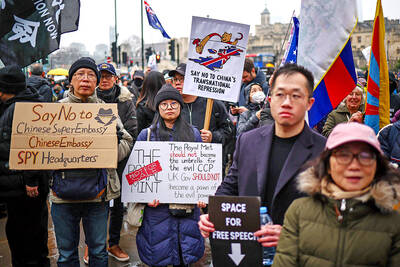For the first time since the 1980s a US Navy nuclear-armed ballistic missile submarine (SSBN) is to visit South Korea to help demonstrate Washington’s resolve to protect the country from a North Korean attack.
The visit was announced in a joint declaration during a summit on Wednesday between South Korean President Yoon Suk-yeol and US President Joe Biden in Washington.
Because US SSBNs rely on secrecy and stealth to ensure their survival and preserve their ability to launch nuclear missiles during a war, they rarely make public stops in foreign ports.

Photo: EPA-EFE
“That could be a huge pressure on North Korea, because usually they don’t share where those submarines are,” said Moon Keun-sik, a retired South Korean submarine captain and squadron leader.
The US has pledged to deploy more so-called “strategic assets,” such as aircraft carriers, submarines and long-range bombers, to South Korea to deter North Korea, which has developed increasingly powerful missiles that can hit targets from South Korea to the US mainland.
The submarine visit is also seen as a way to reassure South Korea and quell talk in Seoul of developing homegrown nuclear weapons.
“If a US SSBN visits and docks in South Korea, that is very unusual and symbolic... The US wants to show it is going for stronger deterrence in a visible way and to calm South Koreans’ concerns,” said Choi Il, another retired South Korean submarine captain.
Pyongyang has condemned the recent deployment of US aircraft carriers and joint South Korea-US military drills as proof of the allies’ hostile intent.
The US Navy fields 14 SSBNs, often referred to as “boomers.” Each of the Ohio-class submarines carry 20 Trident II D5 missiles, each of which can deliver up to eight nuclear warheads to targets as far as 12,000km away.
There were regular SSBN visits to South Korea in the 1970s, during another period when the nation was debating the strength of US commitments and the need for its own nuclear arsenal, a report by the Federation of American Scientists said.
“For a few years the boomers arrived at a steady rate, almost every month, sometimes two to three visits per month,” Hans Kristensen wrote in the report. “Then, in 1981, the visits stopped and the boomers haven’t been back since.”
No further details were provided about the South Korea visit, but the declaration said it would be evidence of the US’ commitment to “further enhance the regular visibility of strategic assets to the Korean Peninsula.”
A senior US official, speaking on condition of anonymity, told reporters that the visit would be part of more frequent trips to the peninsula by strategic assets, but that there is “no vision for any regular stationing or basing of those assets and certainly not nuclear weapons” in South Korea.

Thousands gathered across New Zealand yesterday to celebrate the signing of the country’s founding document and some called for an end to government policies that critics say erode the rights promised to the indigenous Maori population. As the sun rose on the dawn service at Waitangi where the Treaty of Waitangi was first signed between the British Crown and Maori chiefs in 1840, some community leaders called on the government to honor promises made 185 years ago. The call was repeated at peaceful rallies that drew several hundred people later in the day. “This government is attacking tangata whenua [indigenous people] on all

RIGHTS FEARS: A protester said Beijing would use the embassy to catch and send Hong Kongers to China, while a lawmaker said Chinese agents had threatened Britons Hundreds of demonstrators on Saturday protested at a site earmarked for Beijing’s controversial new embassy in London over human rights and security concerns. The new embassy — if approved by the British government — would be the “biggest Chinese embassy in Europe,” one lawmaker said earlier. Protester Iona Boswell, a 40-year-old social worker, said there was “no need for a mega embassy here” and that she believed it would be used to facilitate the “harassment of dissidents.” China has for several years been trying to relocate its embassy, currently in the British capital’s upmarket Marylebone district, to the sprawling historic site in the

The administration of US President Donald Trump has appointed to serve as the top public diplomacy official a former speech writer for Trump with a history of doubts over US foreign policy toward Taiwan and inflammatory comments on women and minorities, at one point saying that "competent white men must be in charge." Darren Beattie has been named the acting undersecretary for public diplomacy and public affairs, a senior US Department of State official said, a role that determines the tone of the US' public messaging in the world. Beattie requires US Senate confirmation to serve on a permanent basis. "Thanks to

‘IMPOSSIBLE’: The authors of the study, which was published in an environment journal, said that the findings appeared grim, but that honesty is necessary for change Holding long-term global warming to 2°C — the fallback target of the Paris climate accord — is now “impossible,” according to a new analysis published by leading scientists. Led by renowned climatologist James Hansen, the paper appears in the journal Environment: Science and Policy for Sustainable Development and concludes that Earth’s climate is more sensitive to rising greenhouse gas emissions than previously thought. Compounding the crisis, Hansen and colleagues argued, is a recent decline in sunlight-blocking aerosol pollution from the shipping industry, which had been mitigating some of the warming. An ambitious climate change scenario outlined by the UN’s climate